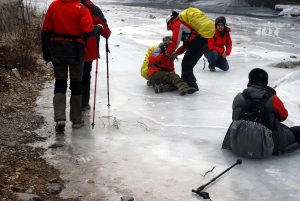Ice safety to most people means hazardous driving conditions. While a lot of folks can’t stand to drive in inclement weather and cannot wait for the winter to end, some people can’t wait for the first major freeze of the season. When the winter months hit, hardy souls throughout the land gather on frozen ponds and lakes to enjoy hockey, ice skating and ice fishing. But how do you know when the ice is thick enough to safely venture on it? To help you stay safe, Security Specialists has outlined these ice safety tips and laid out how to test ice thickness yourself on a frozen body of water.
- Check the ice thickness before you travel on it. There should be at least 10 cm (4 inches) of ice to walk on, 20 cm (8 inches) to drive a snowmobile or ATV on, 30 cm (12 inches) to drive a car or light truck on, and more than 30 cm (12 inches) to drive a heavy truck on.
- Ice thickness depends on the waterbody and surrounding conditions. Ice does not freeze at a uniform thickness and ice strength can vary considerably from one area to another.
- However, ice thickness is just one factor to consider in ice safety. Ice color also should be taken into consideration. Clear blue ice is strongest while white opaque ice (snow ice) is roughly half as strong as blue ice. Opaque ice formed by wet snow freezing on the ice surface. GREY ICE IS UNSAFE. The grey color indicates the presence of water. Clear, hard ice is the only ice recommended for travel.
- Also avoid ice that:
- is slushy in appearance;
- has thawed then frozen again;
- is near moving water;
- is layered, caused by sudden temperature changes; and
has structures on it, such as pressure ridges.
- If You Get into Trouble on The Ice and You’re Alone:
- Call for help.
- Resist the immediate urge to climb back out where you fell in. The ice is weak in this area.
- Use the air trapped in your clothing to get into a floating position on your stomach.
- Reach forward onto the broken ice without pushing down. Kick your legs to push your torso on the ice.
- When you are back on the ice, crawl on your stomach or roll away from the open area with your arms and legs spread out as far as possible to evenly distribute your body weight. Do not stand up! Look for shore and make sure you are going in the right direction.
- If You Are on The Ice with Others:
- Rescuing another person from ice can be dangerous. The safest way to perform a rescue is from shore.
- Call for help. Consider whether you can quickly get help from trained professionals (police, fire fighters or ambulance) or bystanders.
- Check if you can reach the person using a long pole or branch from shore – if so, lie down and extend the pole to the person.
- If you go onto ice, wear a life vest or PFD and carry a long pole or branch to test the ice in front of you. Bring something to reach or throw to the person (e.g., pole, weighted rope, line or tree branch).
- When near the break, lie down to distribute your weight and slowly crawl toward the hole.
- Remaining low, extend or throw your emergency rescue device (pole, rope, line or branch) to the person.
- Have the person kick while you pull them out.
- Move the person to a safe position on shore or where you are sure the ice is thick. Signal for help.
Remember, any activity on ice comes with a risk. By following these common-sense ice safety tips, you and your family can safely enjoy your winter sports activities.
All of us at Security Specialists Want You To Stay Safe This Winter!











